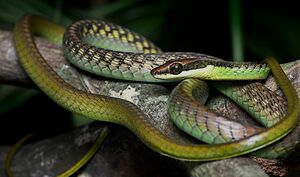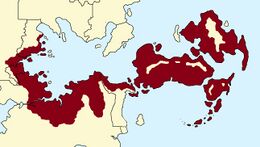Leptovenetus communis
| Common Sibrona | |
|---|---|

| |
| Subadult Leptovenetus communis | |
| Scientific classification | |
| Kingdom: | Animalia
|
| Phylum: | Chordata
|
| Class: | Reptilia
|
| Order: | Squamata
|
| Family: | Colubridae
|
| Genus: | Leptovenetus
|
| Species: | L. communis"
|
| Binomial name | |
| Leptovenetus communis | |

| |
| Range of Leptovenetus communis | |
Leptovenetus communis, the "Common Sibrona", is a species of colubrid snake native to Inyursta and Gran Cuscatlan. In parts of its range it is also called the "Olive Vinewhip" or "Common Vinewhip" due to its semi-arboreal habits and braided scales resembling a whip.
The Sibrona has a mixed reputation in Inyursta. In some regions, it is feared and persecuted due to misidentification with venomous species due to the "triangular head" myth, or outright belief that this species of Sibrona (rather than the closely related Rebellied Sibrona and Lowland Sibrona, which are capable of delivering a medically significant bite) is a life-threatening dangerous species. In others, particularly the rural interior, it is actually respected and let be due to its known diet of birds - particularly finches and parrotlets - which can ravage crop fields.
Habitat
L. communis is a habitat generalist. Any habitat which has ample foliage, including vines, trees and even shrub cover are utilized by this species. It is found across most of Inyursta and countries bordering the Sea of Juarez, except for high altitude habitats such as paramo, montane deserts and rocky slopes.
Coastal tropical dry forests and the edges of true lowland rainforests hold the highest densities of this species.
Life History
Juveniles are less frequently encountered than adults due to a more cryptic lifestyle, spending much time hiding behind loose bark, abandoned birds nests or other areas of earthen debris above the ground. No information is available on home range size of either age class.
Breeding season varies based on region; but generally two to three months prior to the rainy season in most localities. In jungles and freshwater swamplands, they breed all year round. Males fight for mates by twisting and rolling around one another until one gives up. Females lay between 3-16 eggs, with an average of 11. Females can lay a clutch of eggs every year.
Aside from breeding season combat, no level of territorialism is recorded in this species.
Prey
Common Sibronas are active predators which move about and seek out prey in the upper or exposed layers of vegetation. They use a standard bite-and-grab method of subduing prey, sometimes using their body coils to help immobilize and pin the prey.
Prey is comprised mostly of small birds and lizards. Other incidental prey observations include rodents, bats and frogs. No variation between juveniles and adults is known, except for maximum size of targeted prey.
Predators and Disease
Primary predators include birds of prey, such as falcons and caracaras. Large, predatory snakes such as Mussuranas, Cribos and the Greater Smoothsnake. The Northern Ogre Treefrog has been known to feed on juvenile and subadult Sibronas.
Helen & Dorcese (2020) recorded a total of 17 instances of infection of this species with the Afruikahn Reptile Fungus (Ophidiomyces tropicaeudor); 11 instances in Inyursta, 2 in Cuscatlan and 4 in Les Sonorailles. Four of these specimens came from deaths by other causes (road kill, persecuted by villagers), and no lethal pathology has been recorded for this species.
Venom
The Common Sibrona is a mildly venomous, rear-fanged species. Actually envenomations from this species are uncommon, albeit much more frequent than envenomations from any other rear-fanged colubrids in Inyursta, due to the abnormally well-grooved fang structure and ability of Leptovenetus to open their mouths to an over 140° angle when striking.
Clinical effects on humans are rarely considered medically significant; often resulting in localized swelling, sharp pains and residual tingling sensation up to 5 days after envenomation.
Sibronas, particularly this species and the Rebellied Sibrona, posses varying quantities of a unique toxin molecule dubbed "Leptovetoxin". Leptovetoxin is a Phospholipase-A2 enzyme which acts as a slow-acting neurotoxin in reptiles, targeting their central nervous system. It is hypothesized this is done to reduce post-swallow struggle of lizards, resulting in less internal damage to the snake. In mammals, however, it has a mild cytotoxic effect resulting in swelling and sharp tingling pain. Despite this difference in effect, it has shown promise in clinical tests to treat neurological disorders such as Alzheimer's.
Description
L. communis is a long species, reaching upwards of 200cm, but rarely wider than 7cm. Males have significantly longer tails than do females. Dorsal scales are usually wide, highly visible and diamondshaped. Coloration is usually an olive-green across much its range, though in the northwestern sections of its range they are more brownish, while certain cloud forest populations have more lime-green coloration. A yellowish or irridescent, cool-green frosting is usually visible on adult speciments.
Holotype = Female specimen, 105cm TL, 88cm SVL, collected approximately 2 miles west of Gracio, by Eduaro Degas in 1710.

